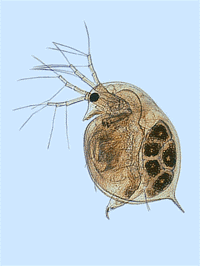
Daphnia eat algae and bacteria. Daphnia are small but you can see them with your unaided eye.

Adult daphnia are about the size of sesame seeds. The circles on the daphnia's back are baby daphnia. In the summer all of the daphnia are females. They reproduce asexually by cloning themselves. In the fall when conditions aren't favorable some males are born. These males and females produce eggs. The eggs hatch in the spring.
Daphnia are crustaceans like crabs and shrimp. Crustaceans don't have bones. They have a hard exoskeleton like a shell. When daphnia grow they become too large for their exoskeleton. Then they discard their old exoskeleton and grow a new one. This process is called molting.
Every two days the adult daphnia molt. When they molt the baby daphnia are born. When daphnia are born they are very small. The adolescent grow for about 8 days.
After 8 days of rapid growth the daphnia start to reproduce. When the daphnia starts to reproduce almost 70% of its energy goes into making more daphnia. If all conditions are perfect, daphnia live approximately 50 days. If there isn't enough food or the water is polluted the daphnia don't live as long.
Environmental scientists often check a pond's health by looking for daphnia. If they find daphnia the pond is healthy. If there are no daphnia the pond may be polluted. The scientists take a sample of pond water back to the lab for analysis.
Twenty years ago EPA scientists analyzed sludge from a sewage-treatment plant. They found excreted aspirin, caffeine, and nicotine. They also found clofibric acid a cholesterol-lowering drug. Today scientists are finding many kinds of medicine in our rivers and lakes. The scientists are concerned that the medicine may harm the plants and animals in the water.
Colleen Flaherty is a Zoology student at the University of Wisconsin-Madison. Colleen has studied the effects of different medicines on daphnia. She raised daphnia in water with the same concentrations of medicines that are found in lakes and rivers.
She raised several groups of daphnia. One batch was the control. This batch didn't have any medicine in the water. A second batch had a cholesterol-lowering drug (clofibric acid) in the water. A third batch had an antidepressant (fluoxetine) in the water. A fourth batch had both clofibric acid and fluoxetine in the water. In each batch she started with one female. She observed all of the offspring for the entire life of the female (about 30 days).
It would take you a month to repeat her studies. If you don't have a month or the equipment to repeat the experiment you can use a computer model.
